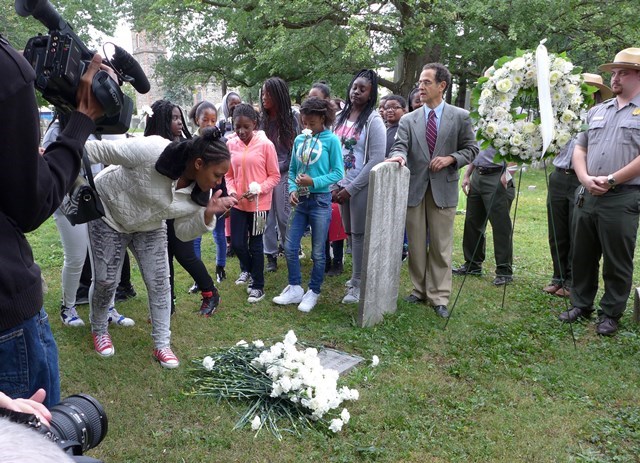
NPS PHOTO by Centennial Volunteer Ambassador Abigail Pope-Brooks The ceremony included several speakers, including students, at St. Paul's Church, followed by a procession to the cemetery accompanied by the African Drum Ensemble. A wreath was placed at the grave site of Rebecca Turner. Each student carried a white carnation flower and placed them on the grave plaque.
Preceding the gravesite ceremony, the fourth and seventh grade students were welcomed to the 350-year-old church by Dr. David Osborn, site manager at St. Paul's Church, NPS Park Ranger Vladimir Merzlyakov and Dr. Kenneth R. Hamilton, superintendent of Mount Vernon City School District. Dr. Osborn noted that the Turners sat in the same church, heard the same bell ring and listened to the same organ play when they were parishioners.
"You don't know how delighted my heart is," exclaimed Dr. Larry Spruill, professor of history at Morehouse College in Atlanta. Dr. Spruill, who spent 40 years researching the history of Rebecca and Benjamin Turner, discussed the historical significance of the Turners. He explained key words like "antiquity," "inclusion," "disinter" and "necropolis," having students repeat them aloud. Rebecca Turner's 93 years spanned the American Revolution to the post-Civil War period, from her own enslavement to emancipation, all in the shadows of St. Paul's Church where she is buried. (The grave site of Benjamin Turner, who died decades before Rebecca, remains unknown.)
Dr. Spruill said that rediscovering Rebecca and Benjamin Turner's history not only illuminates the African-American experience in the Mount Vernon area during this time period, but enriches the full story of American history—a history that belongs to all of us.
Fifth graders Myall Johnson and Jahzeel Stewart and seventh grade student Michael Beharry expressed a connection to Rebecca Turner and the unburying of her history in their speeches. Stewart connected Rebecca Turner to the school's mascot, the eagle: just as an eagle soars, "Rebecca was special because she was born enslaved but wanted to soar to freedom." He concluded, "I am proud to be a student at Rebecca Turner Elementary."
Saint Paul's Church National Historic Site tells the story of the development of colonial society and the road to the American Revolution. It consists of an 18th-century church that was used as a Revolutionary War hospital, a historic cemetery with burial stones dating to 1704 and the remnant of a Village Green that featured prominently in local history, including the Election of 1733, which raised issues of freedom of religion and freedom of the press.

NPS PHOTO |
Last updated: October 7, 2015
